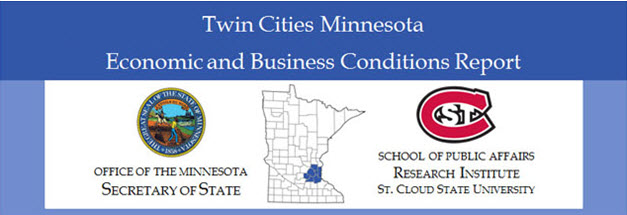Document Type
Research Study
Publication Date
3-2016
Abstract
Twin Cities economic performance is expected to be steady over the next several months according to the prediction of the Twin Cities Index of Leading Economic Indicators (LEI). While the Twin Cities LEI fell by 2.48 points in the fourth quarter, three of the five index components increased and a neutral reading seems warranted by the preponderance of available data. Accounting for the decrease in the index are a reduction in new filings for LLC and incorporation in the fourth quarter as well as a decrease in a general measure of statewide business conditions. Three components had a favorable impact on the leading index in the recent quarter. Lower initial claims for unemployment insurance, an increase in the number of residential building permits in the Twin Cities MSA, and a second measure of general business conditions each made a positive contribution to the fourth quarter LEI.
There were 9,014 new business filings with the Office of the Minnesota Secretary of State in the seven-county metro area in the fourth quarter of 2015—representing a 1.2 percent decrease from one year ago. There were 1,344 new regional business incorporations in the fourth quarter, a 0.1 percent decrease over year ago levels. Fourth quarter new LLC filings fell to 5,440 in the seven-county metro area—a 3.2 percent decrease compared to the fourth quarter of 2014. New assumed names totaled 1,837 in the fourth quarter—an improvement of 2.6 percent from the final quarter of 2014. There were 393 new filings for non-profits in the Twin Cities in the fourth quarter of 2015, 5.9 percent more filings than one year earlier.
Twin Cities employment increased by 2 percent over the year ending December 2015. The regional unemployment rate was 2.9 percent in December, an improvement on its 3.1 percent reading one year earlier. December 2015 initial claims for unemployment insurance were lower than year ago levels, falling by 2.6 percent to 11,702. The average weekly wage in the Twin Cities planning area was $1,098 in the second quarter of 2015. This represents a 3.5 percent increase over the second quarter of 2014. The labor force expanded in the Minneapolis-St. Paul area by 30,834—a 1.9 percent increase over the prior year. After declining since 2010, Twin Cities bankruptcies have now leveled out over the past three quarters. Average weekly hours worked rose in the metro area and the relative cost of living in Minneapolis appears to have increased (but remained unchanged in St. Paul). There was an increase in average hourly earnings in the Twin Cities in the most recent quarter. The value of residential building permits fell by 18.2 percent in the Twin Cities MSA compared to one year ago.
Recommended Citation
MacDonald, Richard A. and Banaian, King, "Twin Cities Area Economic and Business Conditions Report - Fourth Quarter 2015" (2016). Twin Cities Minnesota Economic and Business Conditions Report. 8.
https://repository.stcloudstate.edu/qebcr_tc_mn/8




